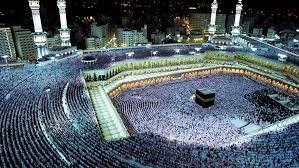A massive movement of humanity is taking place this week. Not migrants seeking refuge from oppression, but two million Muslims seeking spiritual refuge at the House of God, as they make the journey to Mecca to perform the Hajj. As viewers watch news coverage of pilgrims in white garb circling the cubic structure of the Kaaba draped in black, they are likely to assume that pilgrims are honoring the legacy of the Prophet Muhammad. They are less likely to know that the Hajj rituals center on walking in the footsteps of Prophet Abraham and his noble family, Hagar, and Ishmael. Whereas the purpose of the Hajj is to honor God, the choreography and the execution of the Hajj are achieved by re-enacting defining moments in the life of Prophet Abraham, the patriarch of all monotheistic faiths, who according to the Quran, was a Muslim i.e. one who submitted to the will of God. (Quran 3:67). Islam—defined as ‘submission to the will of God’— is not named after the Prophet Muhammad, rather, constitutes a belief; and a Muslim is one who submits to the will of God. Muslims, therefore, believe that Abraham was the founder of Islam, and in participating in the largest gathering on earth, invoke the legacy of Abraham.
In Hagar’s Footsteps
When Abraham took Hagar and baby Ishmael far into the desert and turned to leave, Hagar asked him, “Are you leaving us here at God’s command?” He replied in the affirmative. “Then He will provide for us,” she said. In the intense heat of the desert, the baby started crying. Hagar went looking for water, running back and forth between two hillocks—Safa and Marwa. After her seventh run, a spring gushed forth where the baby was kicking in the burning sand. Mother and son drank to their heart’s content. Some passing Bedouins made a stop, and Hagar gave them permission to drink from the spring, establishing her rights over the water. Soon a city formed around the vicinity of the spring—the city of Mecca. Hagar would go down in history as the founder of the city of Mecca. When pilgrims perform the Hajj, they walk in the footsteps of Hagar, acknowledging her faith in God and commemorating a mother’s struggle for her child. They walk back and forth between the hills of Safa and Marwa and after the seventh run, drink the cool water from the same spring–the zam zam. Many will bring home bottles filled with zam zam for family members. A holy gift, it is believed to have medicinal qualities. If you happen to be at JFK airport in early August, you are likely to see returning pilgrims lifting large 10-gallon plastic water bottles off the belt in Baggage Claim.
In Abraham’s Footsteps
In the years after Abraham left Hagar and Ishmael in the desert, he would return to visit his family. When Ishmael grew up to be a young lad, father and son constructed the Kaaba—a cubic structure—circled it seven times and dedicated it to God. When God revealed the Quran to the Prophet Muhammad, He instructed him to face the direction of the Kaaba when offering the daily prayers and made it obligatory for all Muslims who could afford it, to make the pilgrimage to His house, and in seeking His bounty, circumambulate it as Abraham did. When I performed the Hajj, I wept at the first glimpse of the Kaaba. It’s an overwhelming feeling to know that one is standing at the place one turns to in prayer five times a day, every day. My husband and I joined the throngs of pilgrims—men draped in white sheets, women in black and white—circling it seven times as we walked in Abraham’s footsteps, praying to God for His blessings and His forgiveness. In those moments of spiritual high, the physical hardships become irrelevant: the crush of the crowds and walking barefoot under the blazing sun.
Abraham’s Sacrifice
When Ishmael came of age, Prophet Abraham had a dream in which God commanded him to sacrifice his son. Abraham shared this dream with Ishmael who affirmed that if this was God’s will, then he will willingly offer himself for sacrifice. As he and Ishmael proceeded to the altar of sacrifice, Satan intercepted him and tried to dissuade him. Abraham hurled stones at Satan and continued. Satan interrupted him again and again and each time Abraham repelled him. After the third attempt, Satan gave up. Just as Abraham was about to sacrifice his son, God rescinded his command and told him to sacrifice a ram instead. Abraham had passed God’s test. During the Hajj, pilgrims reenact these events. They will perform the sacrifice of a lamb or sheep by giving their proxy to the Saudi authorities who distribute the meat to the needy. Every day for three days, they will gather pebbles, and hurl seven pebbles at each of the pillars in a symbolic act of purging the devil from their heart and praying that God bless them with the same spiritual strength as Abraham.
On June 28th, Muslims worldwide will celebrate the Eid-ul-Adha festival to honor Abraham. They will sacrifice a lamb and distribute one-third of the meat to the needy, one-third to family and friends, and one-third to themselves. In Muslim-majority countries, families purchase a lamb, keep it in the house, feed it, tend to it, and on the day of Eid-ul-Adha, the butcher will come to the house, the lamb will be slaughtered, and the meat distributed. Here in the US, we will be donating our portion to a charitable organization to feed the hungry. Once again, Muslims will be engaging in a ritual established by Abraham.
Prophet Muhammad’s Legacy
The rituals of Hajj were codified by the Prophet Muhammad when he performed the Hajj and invoked the legacy of Abraham. For fourteen hundred years, Muslims worldwide have been making the pilgrimage to honor God, and His commandment to embrace the religion of Abraham, the one who established the Kaaba, and the ritual sacrifice. In our five daily prayers, we conclude by beseeching God to bless Abraham and his progeny, a testimony that we—Muslims, Christians, and Jews—are all children of Abraham; cousins in faith. The unifying message of the Hajj is a reminder that all monotheistic faiths originated from the same source: the Prophet Abraham (Peace Be Upon Him).
*****************
Read my hajj experiences in my book, ‘It’s Not What You Think.’
Read my blogs dedicated to my son
Hajj Day1: In the Plain of Arafat
Hajj Day 3: Eid ul Adha
Hajj Day 4: Do You Believe in Miracles?
Hajj Day 5: Farewell
Post Hajj: So What's The Point of It?




